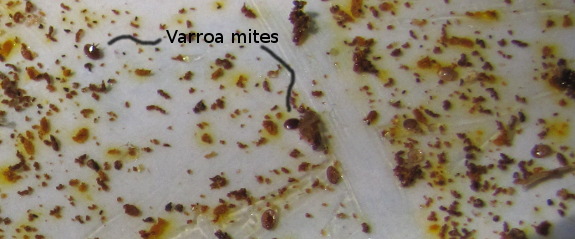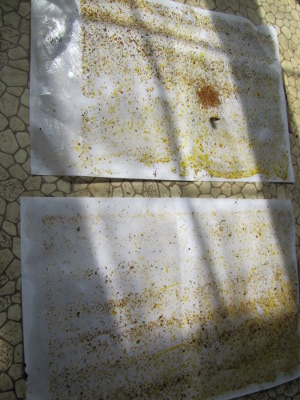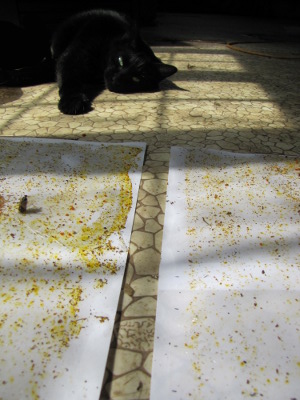
Splitting hive lowers varroa mite population

 Beekeepers
more interested in the health of their bees than in honey production
split hives as a matter of course each
year to lower varroa
mite
numbers. I did a sticky
board test
last week at the same time I'd done one the year before, and the
differences were striking. Here's what the count looked like on
September 13, 2010, in our three hives:
Beekeepers
more interested in the health of their bees than in honey production
split hives as a matter of course each
year to lower varroa
mite
numbers. I did a sticky
board test
last week at the same time I'd done one the year before, and the
differences were striking. Here's what the count looked like on
September 13, 2010, in our three hives:
- East: 90 mites = 30 per day
- Middle: 540 mites = 180 per day
- West: 40 mites = 13 per day
I'm pretty sure that
scattered honey stores were the cause of
the demise of two of my hives last winter, but it's still striking to
see who fell when --- Middle hive was dead in January while West hive
died in March. Perhaps the high mite numbers in the Middle hive
were implicated in that hive's death after all?
 East hive was my sole living hive this spring,
which I then split,
moving the old queen to create a new Middle hive. Although East
hive was the parent location, it's the daughter hive since the bees
left behind had to raise a new queen --- that means they're the hive
that started nearly from scratch this year. September 18, 2011's
three day sticky board count revealed:
East hive was my sole living hive this spring,
which I then split,
moving the old queen to create a new Middle hive. Although East
hive was the parent location, it's the daughter hive since the bees
left behind had to raise a new queen --- that means they're the hive
that started nearly from scratch this year. September 18, 2011's
three day sticky board count revealed:
- East: 131 mites = 44 per day
- Middle: 36 mites = 12 per day
Interestingly, it seems
like more mites hung out in the daughter hive
than in the moved mother hive. Of course, the best news of all is
that both hives are well within normal bounds, so I don't need to worry
about varroa mites unduly weakening either this winter. Since
most
beekeepers around here use chemicals as a matter of course to keep
varroa mites within bounds, it's great to see that something as simple
as a hive split can have such a good effect.
Want more in-depth information? Browse through our books.
Or explore more posts by date or by subject.
About us: Anna Hess and Mark Hamilton spent over a decade living self-sufficiently in the mountains of Virginia before moving north to start over from scratch in the foothills of Ohio. They've experimented with permaculture, no-till gardening, trailersteading, home-based microbusinesses and much more, writing about their adventures in both blogs and books.
Want to be notified when new comments are posted on this page? Click on the RSS button after you add a comment to subscribe to the comment feed, or simply check the box beside "email replies to me" while writing your comment.
